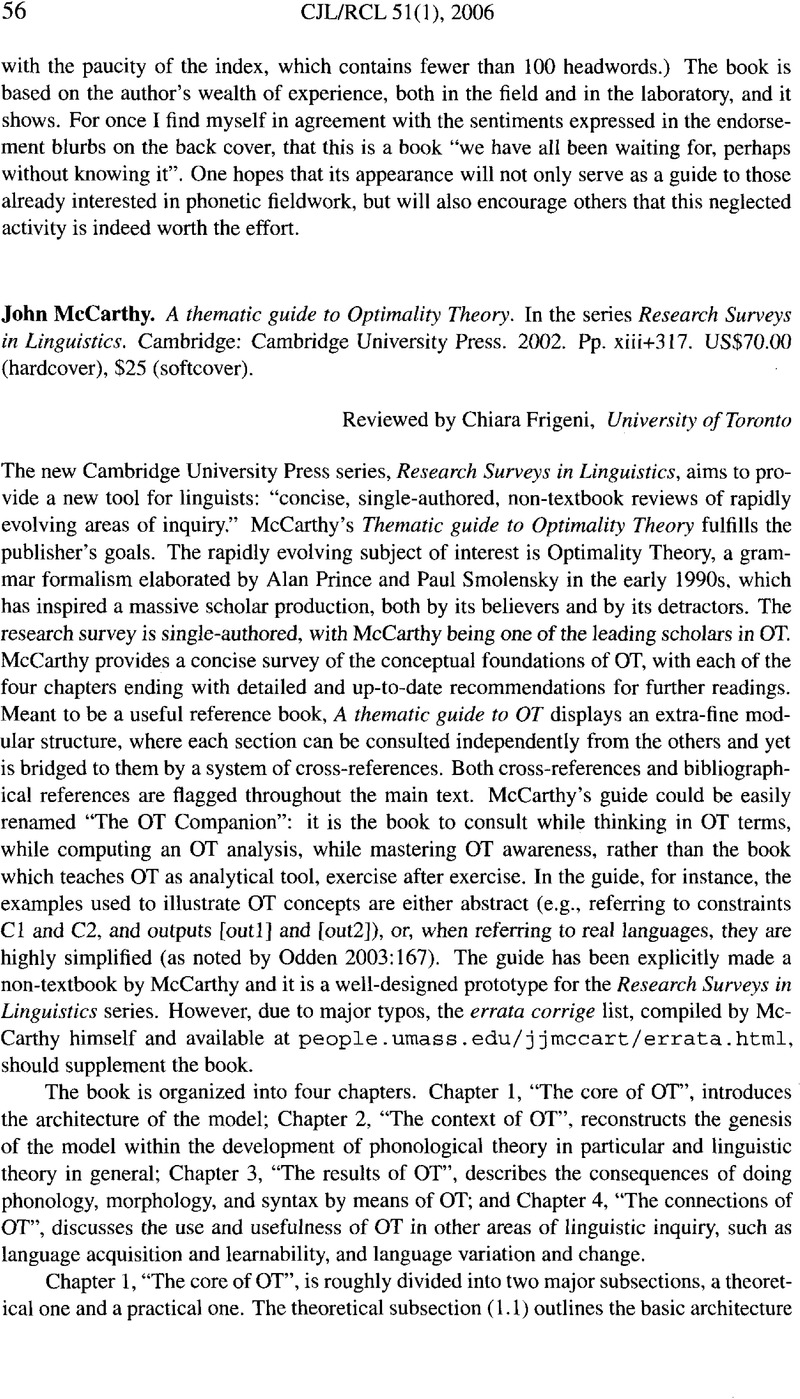No CrossRef data available.
Article contents
John McCarthy. A thematic guide to Optimality Theory. In the series Research Surveys in Linguistics. Cambridge: Cambridge University Press. 2002. Pp. xiii+317. US$70.00 (hardcover), $25 (softcover).
Review products
John McCarthy. A thematic guide to Optimality Theory. In the series Research Surveys in Linguistics. Cambridge: Cambridge University Press. 2002. Pp. xiii+317. US$70.00 (hardcover), $25 (softcover).
Published online by Cambridge University Press: 27 June 2016
Abstract
An abstract is not available for this content so a preview has been provided. Please use the Get access link above for information on how to access this content.

- Type
- Reviews/Comptes rendus
- Information
- Canadian Journal of Linguistics/Revue canadienne de linguistique , Volume 51 , Issue 1 , March 2006 , pp. 56 - 60
- Copyright
- Copyright © Canadian Linguistic Association/Association canadienne de linguistique 2006
References
Chomsky, Noam and Halle, Morris. 1968. The sound pattern of English. New York: Harper and Row.Google Scholar
Jakobson, Roman. 1962. Remarques sur l’évolution phonologique du russe comparée à celle des autres langues slaves. In Roman Jakobson: Selected Writings, Vol. 1: Phonological Studies, 7–116. Berlin: Mouton de Gruyter. [1929.]Google Scholar
Kiparsky, Paul. 1973. Phonological representations. In Three dimensions of linguistic theory, ed. Fujimura, O., 3–136. Tokyo: TEC.Google Scholar
Kiparsky, Paul. 1995. The phonological basis of sound change. In The handbook of Phonological Theory, ed. Goldsmith, John, 640–670. Cambridge, MA: Blackwell.Google Scholar
Labov, William. 1965. On the mechanism of linguistic change. Georgetown University Monographs on Language and Linguistics 18:91–114.Google Scholar
Odden, David. 2003. Review of John McCarthy, A thematic guide to Optimality Theory. Phonology 20:163–167.Google Scholar
Samek-Lodovici, Vieri. 1996. Constraints on subjects: An Optimality Theoretic analysis. Doctoral dissertation, Rutgers University.Google Scholar
Smolensky, Paul. 1983. Schema selection and stochastic inference in modular environments. In Proceedings of the National Conference on Artificial Intelligence 3, 378–382. Menlo Park, CA: American Association for Artificial Intelligence Press.Google Scholar
Stampe, David. 1973. A dissertation on natural phonology. Doctoral dissertation, University of Chicago. [Published by Garland Press, New York, 1979.]Google Scholar
Tesar, Bruce. 1994. Parsing in Optimality Theory: A dynamic programming approach. Report no. CU-CS-714-94. Department of Computer Science, University of Colorado.Google Scholar
Tesar, Bruce, and Smolensky, Paul. 1994. The learnability of Optimality Theory. In Proceedings of the Thirteenth West Coast Conference on Formal Linguistics, ed. Aranovich, Raul, Byrne, William, Preuss, Susanne, and Senturia, Martha, 122–137. Stanford, CA: Center for the Study of Language and Information.Google Scholar




